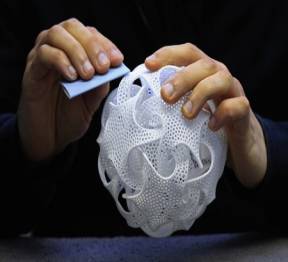
Advantage1: Manufacturing Complex Items Without Increasing Costs, Cost May Decrease by Over 70%.In traditional manufacturing, the more complex the shape of an item, the higher the manufacturing cost. For 3D printers, the cost of producing complex-shaped items does not increase; creating an elaborate, complex-shaped item does not consume more time, skill, or cost than printing a simple cube. The ability to manufacture complex items without increasing costs will disrupt traditional pricing models and fundamentally change how we calculate manufacturing costs. In the future, the cost of products will be based solely on material and volume as fixed costs, while costs like mold opening and precision grinding may not exist.
Advantage2: 3D Printing Can Integrate Components into One Piece, Eliminating the Need for Assembly.Traditional mass production is based on assembly lines. In modern factories, machines produce identical parts, which are then assembled by robots or workers (even across continents). The more components a product has, the more time and cost is spent on assembly. 3D printers can simultaneously print a door and its associated hinges through layered manufacturing, eliminating the need for assembly. Skipping assembly shortens the supply chain and saves on labor and transportation costs. The shorter the supply chain, the less pollution is generated.
Advantage3: 3D Printing Technology Allows On-Demand Printing with Zero Delivery Time.Instant production reduces physical inventory for businesses, allowing them to use 3D printers to create special or customized products based on customer orders, thus enabling new business models. If items are produced on-demand nearby, zero delivery time production can minimize long-distance transportation costs.
Advantage4: Unlimited Design Space.Traditional manufacturing technologies and artisan products have limited shapes, constrained by the tools used. For example, traditional wooden lathes can only produce round items, rolling mills can only process components assembled with milling cutters, and molding machines can only create cast shapes. 3D printers can break through these limitations, opening up vast design spaces and even creating shapes that may only exist in nature.
Advantage5: Zero-Skill Manufacturing, Requires No Specialized Skills or Professionals.Traditional artisans need years of apprenticeship to master the required skills. Mass production and computer-controlled manufacturing machines have reduced the skill requirements; however, traditional manufacturing machines still require skilled professionals for machine adjustments and calibrations. 3D printers receive various instructions from design files to create equally complex items, requiring less operational skill than injection molding machines. Non-skilled manufacturing opens up new business models and provides new ways of production for people in remote environments or extreme conditions.
Advantage6: Additive Manufacturing Used in 3D Printing Greatly Reduces Manufacturing Complexity.Subtractive manufacturing shapes, cuts, and removes raw materials through molds, lathes, etc., to produce final products. In contrast, additive manufacturing is a technique that builds solid parts by gradually adding material. It transforms a three-dimensional object into several two-dimensional planes, producing through material processing and layer-by-layer addition, much like building a wall with bricks. This “bottom-up” manufacturing method significantly reduces manufacturing complexity. This digital manufacturing model does not require complex processes, large machine tools, or extensive manpower; it can directly generate parts of any shape from computer graphic data, extending production capabilities to a broader range of manufacturers.
Advantage7: Unlimited Material Combinations, Multi-Material and Multi-Color Mixing.For today’s manufacturing machines, combining different raw materials into a single product is challenging because traditional manufacturing machines cannot easily merge multiple raw materials during cutting or molding processes. With the development of multi-material 3D printing technology, we can merge different raw materials. Previously incompatible materials will form new materials when mixed, offering a wide variety of colors and unique properties or functions.
Advantage8: Accurate Physical Replication.Digital music files can be endlessly copied without loss of audio quality. In the future, 3D printing will extend digital precision into the physical world. Scanning technology and 3D printing will work together to enhance the resolution of form conversion between the physical and digital worlds, allowing us to scan, edit, and replicate physical objects, creating precise copies or optimizing originals.
Advantage9: No Defective Products, Fully Automated Production, No Human Involvement.Metal parts produced by 3D printing may one day reach or even exceed the levels of traditional manufacturing processes. After all, 3D printing is more cost-effective; when processing a specific part, it does not require lengthy production lines and complex processing procedures, completing everything in one printer, thereby minimizing failure points and virtually eliminating defective products, which traditional manufacturing techniques struggle to match.
Advantage10: Energy Saving and Environmental Protection.In manufacturing, “low carbon emissions” means a more efficient energy-saving design and production method, while low-carbon manufacturing means reducing the carbon footprint throughout the entire product lifecycle, including from product design to production, component assembly, transportation distribution, and final disposal. 3D printing can use various types of materials, especially when printing metals, offering more advantages compared to traditional manufacturing techniques. Almost all leftover metal powder from 3D printing can be recycled. In contrast, traditional metal manufacturing processes (grinding, machining, or casting) are more wasteful; in some metal manufacturing processes, as much as 90% of the raw material remains as waste. For example, manufacturing a 1-kilogram airplane part can consume up to 15 kilograms of metal raw materials.
Consultation Phone:0595-28869063
(Source:Binlin 3D Technology)